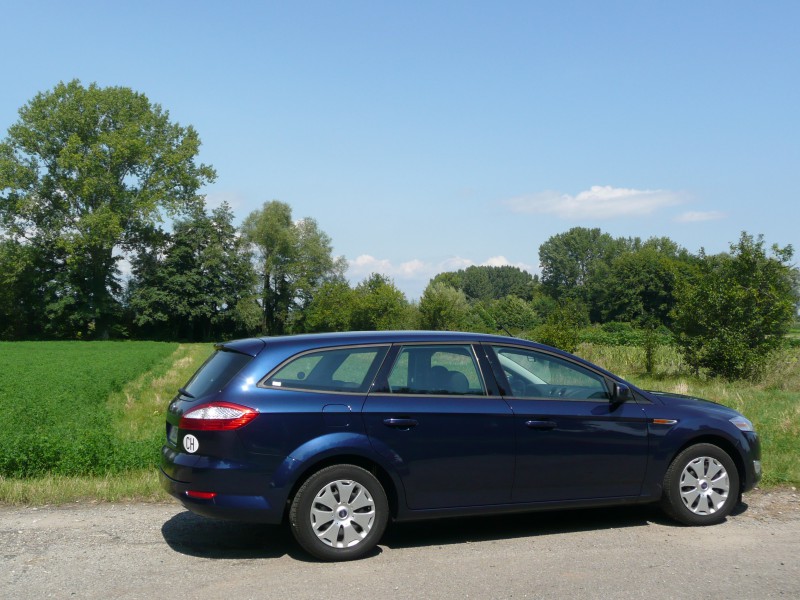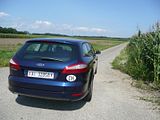

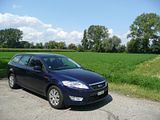
A couple of trends have been evident in the market in recent years: the first is simply that cars are getting larger; the second is that the constant improvement in diesel engine technology have made such engines the de facto selection for an increasing number of motorists, down to ever smaller classes of car. So, when the new, and significantly larger, Mondeo was launched in 2007, all the focus was on the diesel versions, and indeed few road tests of the petrol cars appear to have been published. Indeed, “The Motor” already has a test of the 2.0 TDCi Estate version, so it was with some interest that I took the keys to a 2.0i petrol engined Mondeo estate. With the gap between petrol and diesel prices widening somewhat, earlier this year, many people have indeed been rethinking whether diesel is such a no-brainer, so as well as my first on the road experience of the latest Mondeo, I wanted to see whether the petrol motor is indeed competitive.
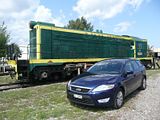
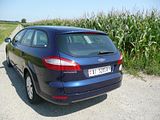
Let’s deal with the size issue first. This is now a very large car. Indeed the saloon version is longer than a 5 Series BMW. The bulk is more effectively disguised with the estate version, which is also, to my eyes at least, by some way the most cohesively styled car of the trio of bodywork options. Although the car does not feel large when you are driving it, parking up is another matter. More than once I paused by a space between 2 cars, with the intent of parking there, but after carefully testing the space out for length, thought better of it, and had to move on elsewhere. Unusually for an estate car, I did also find it surprisingly difficult to judge just where the back of the car ended. Maybe that is just because it is so far away, but also not helped by the various images presented in the mirrors. Having dealt with the downside of all this length (and width), there are of course more upsides. This is a very capacious car indeed, with masses of rear seat space, and a cavernous boot, which can be extended by lifting the rear seat cushions up, and dropping the split backrests down, all done in one simple movement. The resultant space is just vast, and, pleasingly, is flat. There are various small cubby areas at the side of the luggage area, and some underfloor space in the place where you would expect to find a spare wheel.
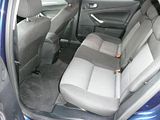
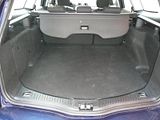
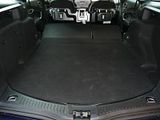
The previous generation Mondeo was widely held to be the best driver’s car in its class, so I was interested to see whether this tradition continues with the new one, or not. Thankfully, it does. Although 145 bhp is not excessive for a car of this size and weight, it proved well up to the job of propelling the Mondeo with the desired urgency, delivering its power in a smooth linear way, completely devoid of the typical turbo-enhanced torque characteristics so redolent of diesel power. The engine is smooth, and revs willingly, although it does get noisier as you near the red line. Coupled with this, there is a very light and precise 5 speed gearbox, with a change quality that allows you to move easily between the gears. The real reason for the driving dynamic accolades for the previous car came, just as with its smaller brother, from the excellent steering and handling. Whilst the Mondeo is perhaps not quite at Focus levels in either area, it does steer well, with a deftness of feel which leaves the driver feeling well informed as to what the wheels are doing, and the car felt just that bit better glued to the road when tackling the twisty bits than any of its competitors, certainly the ones that I have tried. This is combined with a good ride quality – doubtless benefitting from the extra length in the wheelbase.
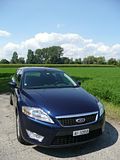
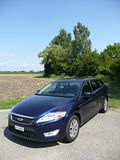
The brakes were good, providing plenty of stopping power, from just a light press of the pedal, and I was very pleased to see that Ford have eschewed the modern mania for electronic handbrakes, and a proper, and effective, pull-up lever is to be found between the two front seats, just where it belongs. Despite the lack of a sixth gear, the car was decently quiet at cruising speeds on the autobahns and autoroutes of the test. And the real reason why people went diesel? The economy levels. Well, I averaged 31.4 mpg during my day, and 410kms in this car. Since most of the miles were done on the motorway, and there were no alpine passes to gobble the fuel, this has to be towards the better end of what you could expect from everyday motoring. Certainly not as good as a diesel, but with the gulf in prices between the two fuel types at present, it would take an awful lot of miles to recover the extra costs of fuel and purchase price of the car.
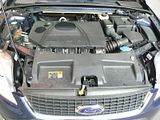
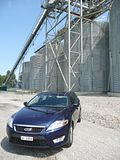
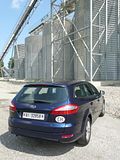
Ford have made it very clear that they want the Mondeo to be perceived as better than just a “reps special”. One way they have tackled this is in trying to limit supply, so that residual values are protected, and this has indeed been effective, with relatively few of the current models yet appearing in UK rental fleets. Another is in the determination to provide a more up-market feel in the trim and ambience of the car. Here I really do not feel they have succeeded. Whilst the general level of design, fit and finish appears extremely good, the overall effect is spoiled by some rather less than upmarket details. The metal-effect silver trim that surrounds the centre console may be better than the execrable fake wood that ruins the Ghia models, but it remains extremely cheap looking, and the effect is made worse by the inclusion go a strip above the glove box, and on the doors of a sort of silver-coloured fake carbon-fibre effect trim that is truly horrid. The soft plastics used for the rest of the dash moulding cannot make up for these indiscretions. There are also several better disguised areas where costs have been saved, such as the fact that the top of the trim under the glove box was detached, and you could see all sorts of mess in the small gap between the seat and the centre console, none of which you would find in a true premium product offering.
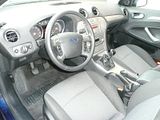
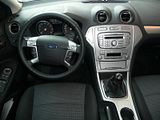
I enjoyed driving the Mondeo. A lot. Anyone interested in one should certainly not rule out the petrol engined cars, at least in 2.0 form, anyway. Thus endowed, I’d say it is probably the best car in its class, at present. How it copes with the challenge of the equally gargantuan Insignia is going to be just as interesting a question as the debates on Sierra v Cavalier in 1982, and early Mondeo v Vectra in 1995 and again in 2002. Until Ford can sort out the interior ambience, there remains more than a badge perception problem in challenging the true premium cars of this type, but then the Mondeo is significantly cheaper than any BMW, Audi or Mercedes. The hard question must be whether that space in the market, much reduced in size and importance from even 5 years ago, will remain sizeable enough for Ford to continue to develop and enhance the Mondeo and its potential successors.














